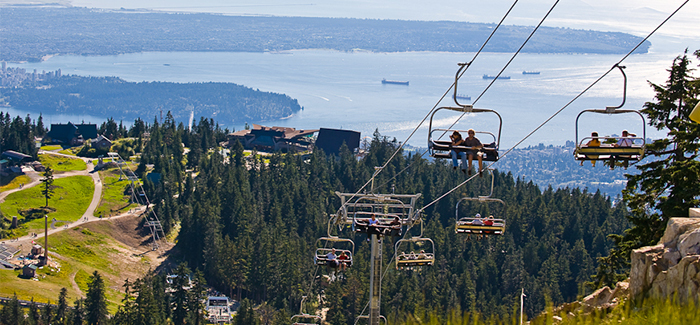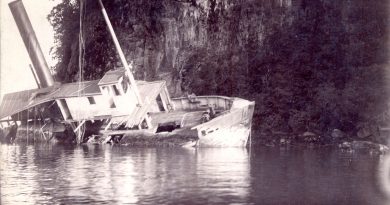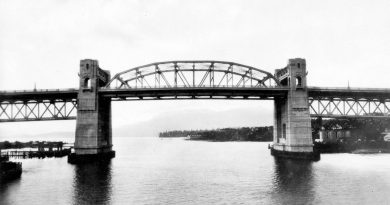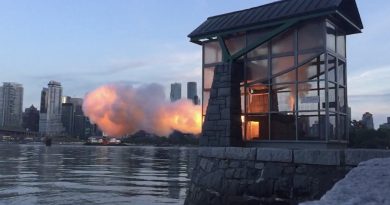Grouse Mountain
It was October 12, 1894. A small party of hikers trudged through the snow of an unnamed mountain on the north shore of Burrard Inlet.
Far below, on the other shore of the inlet, they could clearly see through the crisp, clean fall air the little city of Vancouver—population then about 18,000. The north shore itself had only a few hundred residents. There was no bridge across the inlet yet.
Among the party were Sidney Williams, a surveyor, G.W. Edwards, a photographer, and Ernest Cleveland, later to become chief commissioner of the Greater Vancouver water district (and the man for whom Cleveland Dam is named).
Near the peak the men flushed some blue grouse and shot one. “Gentlemen,” one of them said, “we’ll call this hill Grouse Mountain.”
Hiking up Grouse Mountain became a popular pastime as the population around the inlet grew. By 1910, thousands of people annually were coming off the North Vancouver ferry and walking up Grouse.
One oldtimer, F.W. Hicklenton, remembered counting 300 hikers one winter weekend in 1909. The previous winter, he recalled, “there was 25 feet (8 metres) of snow and toward spring, as the snow melted on the surrounding plateau, my tent was left high in the air and we had to make steps to get up to it.”
A railway!
All those people tramping through the snow to get up the mountain gave someone an idea. In 1911, the idea became the Grouse Mountain Scenic Incline Railway—a company that was supposed to build a 2½ kilometre-long rail line that would carry its passengers up to a lavish resort hotel. The scheme collapsed as the First World War loomed and steel became impossible to obtain.
Visitors to Grouse Mountain had to continue on foot for many more years—it wasn’t until 1926 that someone put a road up there. His name was William Curtis Shelly, a 46-year-old businessman who’d made his fortune in the bakery business. Shelly had come to Vancouver from Ontario in 1910 with 12 years’ experience behind him and by 1928 had organized Canadian Bakeries Ltd., serving all of Western Canada. (The well-known Four X Mills was one of his companies.)
He was active in real estate and shared a dream that a popular resort could be placed atop Grouse Mountain if a road could be built to make it easier to get up there. By 1926, the mountain was swarming with hikers following the construction the year before of a bridge at Second Narrows—not the present one!
Grouse Mountain Highway and Scenic Resort Ltd. was formed to put in a road and build a chalet at the end of it. Shelly and his partners bought 228 hectares (1,800 acres) of the mountain from government and private owners and started their road. It was to be six metres wide, with a grade never exceeding eight per cent. One result of that gradual grade was that the road was 13 kilometres long.
The year 1926 also saw a beginning to the construction of the chalet. At the same time, foundations for a larger hotel were laid because it was intended to eventually convert the original chalet to a ski house.
Shelly’s group built an exceptionally well-made road—at its shallowest, crushed rock extended some 46 centimetres down into the soil, while in some spots the same material went down an astonishing three metres.
By the spring of 1927 the road, christened Mountain Highway, was completed. Some stretches of the original surface are still visible, nearly 80 years later. The road cost $160,000 . . . in 1927 that was a considerably more impressive figure.
Even more impressive was the total cost of the project. Shelly and his partners sank $800,000 into it—so it was with understandably keen regret that, by 1928, they found themselves on the brink of bankruptcy. In December an interim receiver was appointed.
Sunk!
The next year a barge hit the bridge at Second Narrows, damaging it so badly that it was closed for more than four years. The number of visitors plummeted. And those who did come in those Depression years weren’t spending much. By 1934, Shelly knew he was licked.
The re-opening of the bridge that year came too late. By the summer of 1935, even though 8,000 people were coming up every month, the company was unable to pay its bills.
The property and everything on it—road, chalet, light and power lines, water and sewage systems, still-unfinished buildings, and all—reverted to the district of North Vancouver for non-payment of $20,000 in taxes.
The road to Grouse Mountain was ordered closed.
And it stayed closed for many long years.




